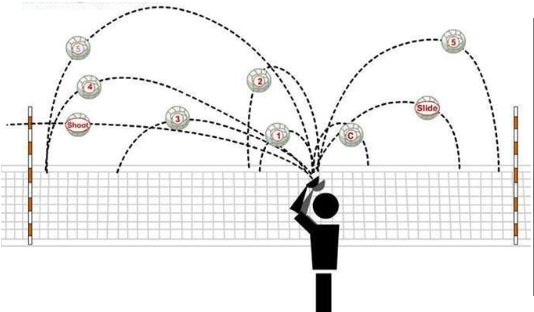passing
passing (En)
To pass the ball to the desired point with the help of fingers or arms. It is the first of the basic moves taken to start the attack. The pass applied by hitting the ball with the fingers of the hand slightly open, forming a triangle between the index and thumb fingers is called ‘finger pass’; the pass applied by combining the arms in front, elbows stretched and hitting the ball by taking force from the legs and shoulders is called ‘cuff pass’.
To pass the ball to the desired point with the help of fingers or arms. It is the first of the basic moves taken to start the attack. The pass applied by hitting the ball with the fingers of the hand slightly open, forming a triangle between the index and thumb fingers is called ‘finger pass’; the pass applied by combining the arms in front, elbows stretched and hitting the ball by taking force from the legs and shoulders is called ‘cuff pass’.
Types of pass:
1. Short pass: A quick pass to the top of the head of the setter, which is usually thrown to the middle players.
2. Lead pass: A low and quick pass to the side facing the setter.
3. One foot pass: The setter's horizontal and quick pass to the No. 2 line.
4. Corner passes: A quick or high pass to the No. 2 or No. 4 area for the corners.
5. Backcourt passes: A pass to No. 1, No. 6, or No. 5.
pas (Tr)
Topu istenilen noktaya parmaklar ya da kollar yardımıyla iletmektir. Hücumun başlaması için atılan temel hareketlerden ilkidir. El parmaklarının hafifçe açık, işaret ve başparmaklar arasında bir üçgen oluşacak şekilde topa vurarak uygulanan pasa “parmak pas”; kolların önde birleştirilerek, dirsekler gergin bir şekilde bacaklardan ve omuzlardan kuvvet alınarak topa vurulmasıyla uygulanan pasa ise “manşet pas” denir.
Topu istenilen noktaya parmaklar ya da kollar yardımıyla iletmektir. Hücumun başlaması için atılan temel hareketlerden ilkidir. El parmaklarının hafifçe açık, işaret ve başparmaklar arasında bir üçgen oluşacak şekilde topa vurarak uygulanan pasa “parmak pas”; kolların önde birleştirilerek, dirsekler gergin bir şekilde bacaklardan ve omuzlardan kuvvet alınarak topa vurulmasıyla uygulanan pasa ise “manşet pas” denir.
Pas çeşitleri:
1. Kısa pas: Genellikle orta oyuculara atılan pasörün başının üzerine doğru attığı çabuk pas.
2. Kurşun pas: Pasörün yüzünün dönük olduğu tarafa doğru attığı alçak ve hızlı pas.
3. Tek ayak pası: Pasörün 2 numaraya doğru attığı yatık ve çabuk pas.
4. Köşe pasları: Köşe oyuncuları için 2 ya da 4 numara bölgelerine atılan hızlı ya da yüksek pas.
5. Arka alan pasları: 1, 6 ya da 5 numaralara atılan pas.
πάσα (En)
Η μεταβίβαση της μπάλας στο επιθυμητό σημείο με τη βοήθεια των δακτύλων ή των βραχιόνων. Είναι η πρώτη από τις βασικές κινήσεις που γίνονται για να ξεκινήσει η επίθεση. Η πάσα που εφαρμόζεται χτυπώντας την μπάλα με τα δάχτυλα του χεριού ελαφρώς ανοιχτά, σχηματίζοντας ένα τρίγωνο μεταξύ του δείκτη και του αντίχειρα, ονομάζεται «πάσα με δάχτυλα». η πάσα που εφαρμόζεται συνδυάζοντας τα χέρια μπροστά, με τεντωμένους αγκώνες και χτυπώντας την μπάλα παίρνοντας δύναμη από τα πόδια και τους ώμους ονομάζεται «μανσέτα».
5. Πάσες πίσω ζώνης: Μια πάσα προς το Νο. 1, Νο. 6 ή Νο. 5.
4. Γωνιακές πάσες: Μια γρήγορη ή υψηλή πάσα στην περιοχή Νο. 2 ή Νο. 4 στις γωνίες.
3. Πάσα ενός ποδιού: Η οριζόντια και γρήγορη πάσα του πασαδόρου προς τη γραμμή Νο. 2.
2. Πάσα μπροστά: Μια χαμηλή και γρήγορη πάσα προς την πλευρά που βλέπει ο πασαδόρος.
1. Κοντή πάσα: Μια γρήγορη πάσα στην κορυφή του κεφαλιού του πασαδόρου, η οποία συνήθως ρίχνεται στους κεντρικούς παίκτες.
Είδη πάσας:
Η μεταβίβαση της μπάλας στο επιθυμητό σημείο με τη βοήθεια των δακτύλων ή των βραχιόνων. Είναι η πρώτη από τις βασικές κινήσεις που γίνονται για να ξεκινήσει η επίθεση. Η πάσα που εφαρμόζεται χτυπώντας την μπάλα με τα δάχτυλα του χεριού ελαφρώς ανοιχτά, σχηματίζοντας ένα τρίγωνο μεταξύ του δείκτη και του αντίχειρα, ονομάζεται «πάσα με δάχτυλα». η πάσα που εφαρμόζεται συνδυάζοντας τα χέρια μπροστά, με τεντωμένους αγκώνες και χτυπώντας την μπάλα παίρνοντας δύναμη από τα πόδια και τους ώμους ονομάζεται «μανσέτα».
passaggio (It)
È l'atto di inviare la palla al punto desiderato con l'aiuto delle dita o delle braccia. È il primo dei movimenti fondamentali per iniziare l'attacco. Il passaggio eseguito colpendo la palla con le dita delle mani leggermente aperte, formando un triangolo tra l'indice e il pollice, è chiamato "palleggio"; il passaggio eseguito unendo le braccia davanti, con i gomiti tesi, prendendo forza dalle gambe e dalle spalle per colpire la palla, è chiamato "bagher".
È l'atto di inviare la palla al punto desiderato con l'aiuto delle dita o delle braccia. È il primo dei movimenti fondamentali per iniziare l'attacco. Il passaggio eseguito colpendo la palla con le dita delle mani leggermente aperte, formando un triangolo tra l'indice e il pollice, è chiamato "palleggio"; il passaggio eseguito unendo le braccia davanti, con i gomiti tesi, prendendo forza dalle gambe e dalle spalle per colpire la palla, è chiamato "bagher".
Tipi di passaggio:
1. Passaggio corto: Un passaggio veloce che il palleggiatore esegue sopra la sua testa, generalmente diretto ai giocatori centrali.
2. Passaggio teso: Un passaggio basso e veloce che il palleggiatore esegue nella direzione verso cui è rivolto.
3. Passaggio a un piede: Un passaggio rapido e piatto che il palleggiatore esegue verso la posizione 2.
4. Passaggi d'ala: Passaggi veloci o alti diretti verso le zone 2 o 4 per i giocatori di banda.
5. Passaggi di seconda linea: Passaggi diretti alle posizioni 1, 6 o 5.
